Things may be bad, but at least you don’t have to do laundry with a giant fork 15 Nov 2017 11:07 AM (7 years ago)
Or, click here for a somewhat more accurate history of laundry:
http://www.oldandinteresting.com/history-of-washing-clothes.aspx
3 Sure-Fire Ways to Spot an Appliance Repair Hack in Your Home 18 Aug 2015 12:24 PM (9 years ago)
A Consumer’s Guide to Recognizing Charlatans, Hacks, and Parts Changing Monkeys in the Appliance Repair Trade
Have you or someone you love been victimized by an appliance hack?
Have your appliances been defiled by a Parts Changing Monkey?
Do you feel clueless when trying to decide which appliance repair company to hire?
Do you feel helpless and vulnerable when trying to evaluate the accuracy (and truthfulness) of the guy standing in your home telling you what’s wrong with your refrigerator?
To protect your appliances, your precious time, and your wallet from incompetent repairmen, first you need to know a little bit about the trade.
The Problem with the Appliance Repair Trade Today
An epidemic of ignorance exists in the appliance repair trade today. In fact, there is a shortage of skilled labor in all of the skilled trades across all sectors of the US economy. For a variety of complicated reasons, all the subject of a separate interesting and scintillating article, the appliance repair trade in particular has been hit by a brain drain and a critical skill shortage. This has actually been building for the past 20 years but has become particularly acute in the last five or so years as appliances have become more computerized and more complicated to troubleshoot.
This situation leaves consumers especially vulnerable. On the one hand, more complicated appliances makes it even more difficult for consumers to understand how the appliance works. On the other hand, it has accentuated a critical skill gap that already existed in the trade because many of the guys who were able to get by on the older, simpler appliances by simply guessing and changing parts find that it’s a much more expensive proposition to do that on these new, electronic appliances with their pricey control boards. And who ends up paying for their ignorance and guesswork? You got it: YOU the consumer.
In the trade, the remnant of us real technicians call these bad actors various names such as hacks and charlatans. But the most common one that you will hear among the Appliantological Illuminati is Parts Changing Monkey (PCM).
You are not alone! The manufacturers are also getting screwed big time by these PCMs. That’s because they have to hire these PCMs to do their warranty work. So, Monkey Boy goes out on the service call, guesses the wrong part, then has to order another part and come back at a later date to try his next guess. This costs the manufacturer money in extra parts and it costs you aggra-dollars– time and inconvenience in a delayed repair for something that should have been done in the first trip and in a timely manner.
If these PCMs are so gawd-awful, then why are the manufacturers even using them? The answer is: What other choice do they have? Yep, it’s slim pickins out in the appliance repair technician field today.
The other fact of life is that the manufacturers pay so little for warranty work that many of the sharp technicians choose not to do it and instead focus exclusively on the more profitable COD work. The end result is that getting a warranty technician is often (not always) a lot like getting a public defender; you’re usually getting a second or third rate guy.
By the way, these are the same guys that the manufacturer will refer you to if you call them to ask for their “authorized servicers.” You will still need to evaluate these guys yourself!
Who am I to be telling you what constitutes a charlatan, hack, and PCM? Well, if you’re really interested, you can read my bio. Over the last couple of decades I’ve been running my own service business and I’ve also interacted with thousands of consumers and techs, as well as many manufacturers, through my online appliance tech-help (Appliantology.org) and tech-training (MasterSamuraiTech.com) websites. I know what’s out there– the good, the bad, and the butt-ugly.
So, the burning question you’re asking yourself right now is, “How is the hapless consumer to recognize a Parts Changing Monkey when he’s telling me what he thinks is wrong with my appliance?”
Come with me now on a Journey of Total Appliance Enlightenment…
How to Recognize a Charlatan, Hack, or PCM in Your Home
1. If your “tech” walks in and sees you have a Samsung, LG, or Miele (or other higher-end brand) and immediately goes off on how these brands are junk and how you need to get yourself a Whirlpool, this is a surefire sign that the guy is a hack. A lot of parts-changers don’t like Samsung, LG, etc. because those brands have a lot of new, electronic parts and control boards in their appliances, which require technical skills such as reading the schematic diagrams and taking electrical measurements to accurately troubleshoot the problem.
Parts-changers don’t know how to read schematics and therefore don’t know how to make real diagnoses, and despite the availability of ways to learn that skill they refuse, out of laziness or pride, to learn real troubleshooting. Willful ignorance is rampant among appliance hacks. They like brands like Whirlpool because they are familiar with them and know how to change the right parts to fix common problems. If a “tech” comes into your home and acts like this, you’ll know what he really is.
2. The second indicator that a “tech” is really a PCM is when he is confronted with a warming refrigerator and says that it “needs more Freon” in the sealed system. This should rarely–if ever–be done to a fridge. The procedure to add refrigerant is time-consuming and expensive, and for most models, really not worth it compared to the cost of replacing the fridge. Furthermore, most of the causes of a warming refrigerator are in the defrost system, fans, or controls, not the sealed system.
3. The most infamous charlatans out there like to a play a certain game with their customers. After the problem has been “diagnosed”, they’ll replace a part. If that doesn’t fix the problem, the hacks just say “Oh, it must have been something else in addition to that”, and replace yet another part. They continue to charge you, the customer, for each part they replace. In other words, you are paying for them to guess at which parts will fix the problem until they finally get the right one.
There are very few instances where a trained and skilled technician would troubleshoot your appliance and justifiably not be able to tell that a second part was involved in the problem. And if he did miss that the first time around, a good and honest technician will own up to that oversight and not charge you as if there was nothing he could have done about it.
In particular, if a servicer wants to replace a control board, ask him what will happen if that doesn’t fix the problem. PCM’s are infamous for not being able to accurately diagnose a faulty board and will often guess at it. If they answer “you’ll still have to pay for it,” show him the door. A real technician who knows how to troubleshoot will be confident in his diagnosis, will be able to explain it to you, and will stand behind the repair.
If you’ve experienced any of these three behaviors from an appliance servicer, it’s time to try someone else! Look for a technician who invests in his training, including ongoing training over the years. Many of the best techs are active at Appliantology.org and/or get their training from reputable training institutions such as the Samurai Tech Academy!
Refrigerator Maintenance Tips 16 Apr 2015 12:13 PM (10 years ago)
Help your fridge run optimally with occasional cleaning of the gaskets and the condenser. The brush shown in the video can be purchased online or at a hardware store.
NOTE: Even if you don’t feel able or comfortable pulling the refrigerator out and cleaning the back compartment, just cleaning underneath from the front can make a big difference.
Where Should My Refrigerator Controls Be Set? 16 Apr 2015 12:06 PM (10 years ago)
How to set the controls on your fridge for optimum performance can be just a bit mysterious. Watch and learn what to do!
Is Your Refrigerator in the Danger Zone? 16 Apr 2015 12:02 PM (10 years ago)
A light-hearted look at the importance of monitoring the temperatures in your fridge!
“Where should I set my refrigerator controls?” 27 Jan 2014 4:42 PM (11 years ago)
I can’t tell you how many times I’ve been on a refrigerator service call and the customer asks me, “I have my controls set on 5. Where should I set them?” In almost every case, I notice that they do not have any thermometers in their fridge. Now I prepare Standard Answer #637 where I explain to my customer that the single most important indicator of a refrigerator’s health – and the way they determine where to set the controls – is by measuring the temperatures inside the freezer and fresh food compartments.
So that’s the whole point of this blog post: to help you, my valued customer, to appreciate the importance of temperature measurement in a refrigerator and to give you the means by which to do it.
First, as mentioned, you have to appreciate that temperature is, in fact, the single most important number that tells the story about the health of your box. Makes sense for a refrigerator, right? Further, home refrigerators are very sensitive to changes in conditions and usage: changes in ambient temperature throughout the seasons; frequency and duration of door openings; condition of the door gaskets and their ability to seal out warm, humid outside air; the temperature of foods placed inside the compartments; amount of pet fur on the condenser, etc.
Next, unless your refrigerator controls actually measure and display the temperatures inside the compartments, the indexing numbers provided on the controls are simply a way for you to note the relative changes that you need to make to the control dials in order to achieve the target temperatures inside the compartments. And how are you going to know what those target temperatures are unless you are actually measuring the temperatures inside the compartments?
This is where refrigerator thermometers come into play. You should buy two of these refrigerator thermometers right now and keep one of these thermometers in each compartment of your refrigerator box: fresh food and freezer. Here’s how to use the thermometers to set your refrigerator controls according to temperature measurements.
Fresh-food compartment:
For normal, day-to-day tracking of the temperature, place the thermometer in the central area of the compartment (not on the door). Ideally you want it to be easily visible whenever you open the door so that you can glance at the display regularly. Make it a habit to look at the thermometer at least once a day, perhaps in the morning the first time you open the door. The needle should be in the purple “REF.” section, approximately 33 to 40 degrees.
Be aware that opening the door of the fridge, particularly if the ambient conditions are warm and/or humid, can raise the temperature quite a bit in the compartment. If you notice that the temperature is above 40, and the door has been opened recently, leave the door closed for awhile then check the temperature again.
If the temperature is consistently above 40 by a few degrees, you should adjust the cold controls of your refrigerator to see if you can get it down into the 30’s. (See your fridge’s instruction manual for help on this – how to adjust the controls can vary among different brands and models.) Any adjustment to the controls can take several hours or overnight for the temperatures to settle to their new level.
Freezer:
Place the thermometer in a central location in your freezer and monitor the temperatures as described above. Although frozen food is safe at any temperature below 32 degrees (the blue zone), a normally-operating freezer should be between 0 and 5 degrees. If you see temperatures consistently above that, try adjusting the freezer’s control to a colder setting.
If your temperatures remain above-normal despite adjusting the refrigerator’s controls, call The Appliance Guru at 603-290-5515 for service as soon as possible to avoid food spoilage and loss.
Kenmore: Just another brand or yet another scam? 15 Jan 2014 4:41 PM (11 years ago)
Sears is a popular place to buy appliances because they are located all over the country, they frequently have special offers, and they are an old, familiar name. When you stroll through the rows of shiny machines in a Sears store you see all the major brands, including lots of Kenmores. Does buying this “Sears brand” have any downside for the consumer? Ya sure, ya betcha!
Although there are still a few folks who haven’t gotten the memo yet, most people understand that there ain’t no Kenmore factory in Malaysia or some place. The Kenmore “factory” is several floors in an office building where corporate bureaucrats from Sears schmooze with other corporate bureaucrats from real manufacturing companies, like Whirlpool or Electrolux or LG, and get them to make their stuff for them and slap a Kenmore label on it.
“So what?” you say, “I like Sears and I don’t mind spending my money with them.” Well, there’s more. Check this out and see if you still feel so sure…
Kenmore is essentially a marketing gimmick that Sears uses to sell you appliances at a higher profit margin. The Kenmore game is this: sell you a Kenmore-branded appliance, sell you an extended warranty on the appliance or, even if you don’t buy the extended warranty, get you to call them when (not if) it breaks, and to sell you replacement parts and accessories for the appliance. It’s a complete package designed to keep you on the Kenmore plantation, spending your money exclusively with Sears.
This wouldn’t necessarily a bad thing, as long as you are aware of this scheme and a willing participant, if there weren’t other downsides to Sears inserting themselves between the customer and the original equipment manufacturer (“OEM”) of the appliance.
Downside No. 1: Information Blockade
It is difficult if nigh on impossible to cross over the Kenmore model number to that of the OEM’s version of the same machine. This means if you or an independent servicer would like to work on your Kenmore machine, you cannot easily access the manufacturer’s service bulletins or manuals, which may leave you at the mercy of Sears “service.” Most people don’t like to limit their options that way, particularly given Sear’s service reputation. More on that below…
Downside No. 2: Stuck with Sears for Warranty Issues
When you buy a Kenmore machine and it needs warranty service, it will be performed by Sears rather than the local independent servicers who usually handle warranty work for the manufacturers. How bad this is for customers varies from place to place, but in my considerable experience in dealing with folks who have been in this situation, they have had much less frustration in dealing with an OEM company compared to Sears for warranty issues.
Are they really that bad?
Sears has a reputation for slow, inconvenient scheduling and ill-trained technicians who frequently don’t get the repair done correctly. OEM companies, on the other hand, tend to be much more interested in keeping their customers happy by dealing with problems promptly and fairly. We are drawing on years of feedback from customers, but, of course, your mileage may vary.
Bottom line: Sears is the only entity that really benefits from the Kenmore brand. There are no actual upsides for the customer (compared to buying an OEM brand), but there are significant potential downsides when your appliance needs to be serviced.
What to do?
Buy an OEM appliance. If you like shopping at Sears for some reason, they do offer OEM machines that you can choose. Assuming you don’t fall for, er, I mean opt for, the extended warranty, then any warranty issues would be handled through the manufacturer and their local authorized servicer. And when service is needed after the warranty period, you will have many more options for service since you won’t be subject to the Kenmore Information Blockade.
The Appliance Guru
Diagnosing Catastrophic Front Load Washer Drum Bearing and Inner Basket Failures 30 Dec 2013 4:40 PM (11 years ago)
Front Load Washers Rule!
First, lemme start off by saying I love front load washers. I think they offer the best clothes washing technology out there combining low water use with a gentle tumble wash that’s easy on the fabrics, making your clothes last longer, and does a very thorough job of cleaning the clothes compared to the high efficiency (HE) top load washers.
We’re a family of five with dogs and cats. We’ve used a front load washer for many years at our house and, aside from routine repairs, have never had any washability or odor complaints. You’ll hear some people complain about these issues with their front loader but, in almost every case I’ve seen during service calls, it’s been due to user error– usually using too much or the wrong type of detergent.
The Economics of a Repair
Okay, so front load washers: rah-rah, go team go. Why have a special post dedicated to front load washer drum bearing and inner basket failures?
Because these failures are usually considered a “total” event (as in “Dude, I totalled my car last night”) by professional Appliantologists due of the huge cost of the repair. Not only are the parts expensive (sometimes more than $500) but the job itself can take more than three hours (depending on the particular nightmares you run into) and usually require a second man… or one with a very strong back, though it may not be after completing one of these repairs solo!
Everything is repairable. The question is: does it make economic sense to do the repair?
There are two circumstances where it may make economic sense to repair a failed drum bearing or inner basket support spider:
1. You are going to do the repair yourself, so you’re only paying for parts.
2. The machine is still under full or partial manufacturer’s warranty and some or all of the cost of the repair will be covered.
So, if you’re in a situation where neither of the above conditions apply, wouldn’t it be nice if you could positively diagnose a bearing or basket failure on your own and at least save yourself the cost of a service call? Ya sure, ya betcha! And hence, the raison d’être for this post.
How to Tell if Your Washer has Bad Drum Bearings or a Broken Inner Basket
Okay, enough talk. Let’s do some basic watching and listening.
1. Broken Inner Basket
The inner basket is supported in the back by a special metal structure called a “spider.” The spider has three support members that extend from the basket hub to the outer perimeter. A common failure is for the support members to corrode by galvanic corrosion, eventually weakening the metal to the point that it breaks. Here’s an example of what that looks like, this particular washer is a Frigidaire but this is typical regardless of brand:
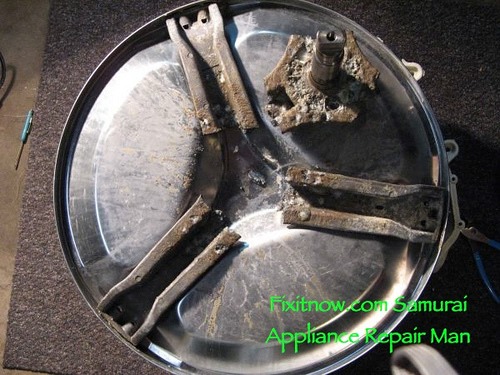
Here’s another example, but this is from a GE front loader:
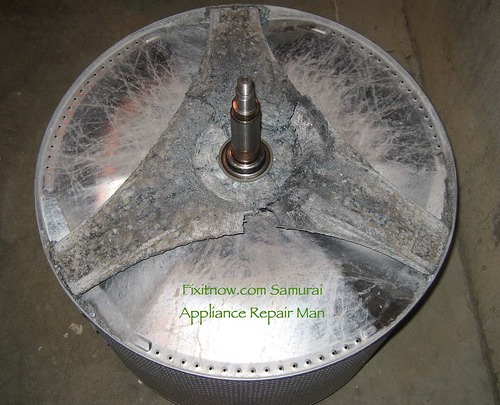
What you see in these photos is called galvanic corrosion. Various theories abound as to whence cometh this galvanic doo-doo. Some of the more plausible ones include:
– Dissimilar metals used in the support members vs. the basket metal itself.
– Certain combinations of hard water and detergents.
– Running the washer on a non-grounded or improperly grounded outlet.
Regardless of the cause, which is a whole separate and interesting engineering discussion, if this happens to your washer, your immediate tasks are to 1) properly and positively identify this failure and 2) decide whether to repair or replace based on the economics of the situation.
2. Bad Drum Bearings
This failure usually manifests as a roaring noise during the spin cycle. This first video demonstrates the tell-tale sound of bad drum bearings:
In advanced stages of this failure, you can also diagnose bad bearings manually using this technique:
Ruh-row, trouble in washer-land! These drum bearings are factory-pressed into the back half of the drum. So it’s not like you can buy a set of OEM bearings, pop ’em in and off you go. You have to replace the whole drum, at least the back half, with the factory-installed bearings. Problem is that you’ll usually find the drive shaft on the inner basket so corroded that you’ll need to replace the inner basket at the same time. Double whammy!
If you look around the Internet, you’ll find third-party bearings that claim to be a drop-in replacement for the factory-installed bearings. I’ve not heard of a single case of this repair lasting more than a few months. If you’ve done this repair and have gotten longer than a year out of it, send me proof and you’ll be a rock star.
The reason these third-party bearings have such a dismal reliability record is because the tolerance on these bearings is astonishingly tight. When you consider the pressure and speeds that these bearings need to work in, it’s amazing they last as long as they do. These bearings are actually a precision-machined piece and that’s why they have to be installed at the factory for maximum reliability.
What about Protection Plans or Extended Warranties for New Appliances? Are they worth buying? 7 Dec 2013 4:39 PM (11 years ago)
I get asked about new appliance protection plans and extended warranties a lot both during real-life service calls as The Appliance Guru and via emails from my DIY appliance repair site. So, FWIW, I thought I’d offer my contemplations and musings on the topic.
First off, you gotta realize that protection plans and extended warranties are only as good as the people offering or doing the actual service work. Protection plans are basically a form of insurance. Lots of companies wants to get in on the protection plan biz because, structured correctly, it’s a highly lucrative arrangement: you pay a chunk of money for service that the warranty company is betting you won’t need. Insurance companies have this game figured out in all aspects of our lives, including home and appliance warranties.
But there’s one big difference.
In auto, home, and medical insurance, for example, all the insurance company has to do is write a check for a claim. Insurance companies are all about cash so even writing big checks are no problem for them.
Now consider an appliance repair insurance plan— which is basically what protection plan and extended warranties are. When a claim is made, what’s the payout? Instead of a check, the payout is usually a repair. And herein lies the dirty little secret about appliance protection plans: they are only as good as the repair services available in your area, as in a live, skilled technician coming to your house and fixing your broken stuff.
When you’re being sold on the plan, they’re trying to implant the Fantasy Scenario vision in your head:
The Fantasy Scenario
The technician gets there the same day or next day, knows exactly what the problem is, has the part on his vehicle and gets you all fixed up right then and there. This almost never happens in a real-world warranty situation but that’s the fantasy when you buy the plan.
Okay, let’s come back to planet earth and look at how these protection plans work in the real world.
Suppose something breaks and you need service. Depending on who is actually providing the service for the protection plan, the response will likely be one of the following scenarios:
The Typical Sears Scenario
You call and get an appointment for two weeks from now. If you’re lucky, you’ll get a decent tech who can troubleshoot the problem accurately. But much of the time you’ll get an undertrained guy who “thinks” he knows what the problem is but, since corporate policy prohibits him from carrying inventory on his service vehicle (to prevent employee theft and moonlighting), he has to order the parts and come back. That’ll take another two weeks. On the second trip, the servicer installs the new part only to realize that he guessed wrong. Whups! “Golly, ma’am, must be sumpin’ else!” Or, “Dang, another bad board outta the box, that’s the 5th time today!” He scratches his head, takes a guess at another part, and has to come back yet again. Each trip is a four hour window for the servicer’s arrival so that’s two or more half-days you’ll need to take off work to wait for him. Oh, and they may call you on the day of the scheduled appointment to cancel for that day and re-schedule.
The Typical Home Warranty Company Scenario
There are several of these types of companies out there– NEW, American Home Shield, and others. They all work the same way: you pay them for an appliance warranty plan (repair insurance) and, in return, they’ll cover any repairs that need to be done under warranty. Sounds great on paper and they do a great job selling these plans. But, as you might expect, there are not one, but two big Achilles’ Heels with this arrangement.
1. Their service is only as good as the independent servicers they can find in your area. If you live in a densely populated area, this may be a non-issue. But if you live in a sparsely populated area, this could be a problem. The warranty company won’t have any easier time finding a qualified servicer than you would on your own. In fact, they’ll have a harder time because of the second Achilles’ Heel:
2. Most independent servicers hate working for warranty companies because 1) they are difficult to deal with like any corporate bureaucracy, 2) they are either slow to pay or pay very little compared to COD rates, or 3) they have gotten a reputation in the industry for stiffing servicers and not paying at all after the repair is successfully completed so, as a result, many independent service companies flat out refuse to work with particular warranty companies. The result is a delay in finding a servicer willing to work with the warranty company which means a delay in getting your stuff fixed. This miserable process usually culminates with you spending hours on the phone with the warranty company (most of that time on hold listening to blaring muzak or repetitive announcements telling you how awesome they are).
Protection Plans from Independent Retailers
This requires careful investigation on your part because, again, their warranty is only as good as the service to back it up. Some dealers service what they sell. Okay, fine. But are their technicians any good or are they parts changing monkeys? Hard to know. One way to find out, though, is to use the Internet and see what people are saying about them on places like Google reviews, YP.com, and the Better Business Bureau. Do a Google search of the company’s name and see what you come up with.
Most service companies should have a company website that tells how they do business and a social web presence, at least a Facebook Page. If they don’t, that’s a red flag right there. I don’t say that because I’m a Facebook fanboy, but because it shows something about the company– that they have a public reputation they are cultivating and want to protect. It also shows that they’re in business for the long-haul.
If you are inclined to go the protection plan route, a good way to go is with a local dealer who services what they sell and one whom you have personally vetted nine ways to Sunday. You don’t want to end up in the situation where you call your local dealer for a protection plan service only to find that their phone has been disconnected. Hey, a lot more common and possible in today’s economy that you may think.
What would I do if I were me? No, wait: what should you do if you were you? No, wait…
IMHO, the best thing to do is to find a good local servicer (using the vetting suggestions discussed above) and establish a relationship with them. Some may offer some kind of protection plan you can purchase. Otherwise, just budget a little money each month into savings to cover eventual repairs.
Here are a few more vetting strategies…
If you don’t get a live human when you first call, don’t leave a message. Call back another time and see if you get a human then. You’re looking to see if getting voicemail is how these people roll or was that a fluke due to bad cell reception or something else going on with them. You want a service company that strives to always answer the phone, even after hours and on weekends. Honestly, in this day and age of cell phones, there’s no excuse for not doing this… unless they just don’t care whether or not they get your work. And that’s what you’re trying to assess.
You also want to find out what their typical response time is. What do they claim their response time is at their website? You’re looking for someone who strives for same day-next day service. The best service companies will offer Saturdays as a regular working day because that’s when people are home and it’s convenient for them (that’s why it’s called appliance repair service).
Once you’ve found this golden service company, cherish them, woo them, nurture that relationship, send them Christmas cards, bake them Kwanza cookies, carve them Hanukah dradles, knit them Ramadan kufis, whatever you think will solidify your connection with them because, when your fridge breaks on a Saturday and you have a houseful of guests, you want them out there that day to get that box cooling again taco-pronto.
If you have the supreme good fortune of living in the Kearsarge-Lake Sunapee Region of New Hampshire, call The Appliance Guru for fast, expert appliance service, including weekend and holiday emergency service at no extra charge. Learn more here: www.ApplianceGuru.com
Soot: A Clear and Present Danger in your Gas Oven 6 Dec 2013 4:38 PM (11 years ago)
I was at a service call on gas range the other day for an oven that wouldn’t bake or broil. The cause turned out to be a bad range control board. Nothing unusual about that. The astonishing thing with this range was the inside of the oven cell– all the surfaces inside were coated with a thick layer of soot:
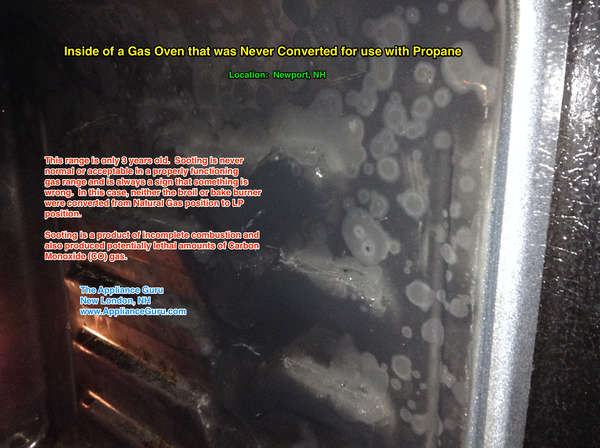
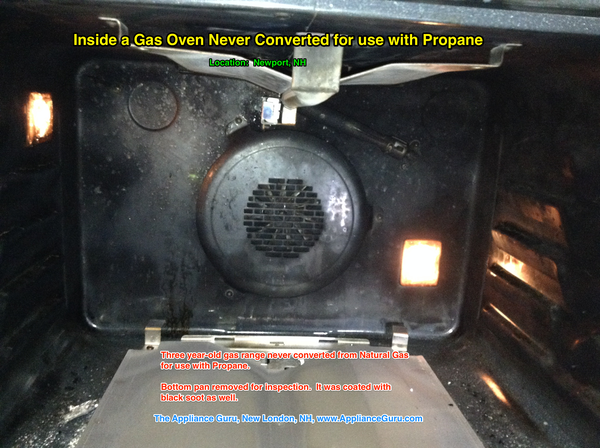
This is NOT a normal condition in any gas range. If you see soot accumulated on your oven cell walls, even a little, STOP USING IT AND GET IT CHECKED OUT!
Soot is a product of incomplete combustion. So is Carbon Monoxide (CO), dubbed “the silent killer” because it is odorless and kills by displacing oxygen in your blood, making you sleepy and, in high enough concentrations, can make you take that final dirt nap. We’ve all heard the stories of people dying in their homes from CO poisoning. Improperly adjusted gas appliances, like the the oven shown in the photos above, is one of the more common ways this happens.
A standard practice in the appliance industry is that all gas appliances, ranges, ovens, dryers, etc., come ready to burn natural gas. If you’re going to use propane (also abbreviated LP for “liquid propane”), you have to convert the gas system in the appliance to safely burn it without producing soot or unsafe levels of CO.
Since propane burns hotter than natural gas (2,500 Btu/cu ft for propane vs. 1,030 Btu/cu ft for natural gas), it needs more air to make a “complete” (or at least safe and soot-free) combustion. If the air-fuel ratio (AFR) is too low (too much fuel or “too rich” in automobile terms), you’ll create soot and unsafe levels of CO. If you’re interested in some numbers on the AFR for natural gas and propane, start here.
While no combustion is 100% complete, you can still get close enough to prevent soot formation and keep CO production to safe levels.
The range in this service call is a Kenmore (Frigidaire-built) range that was purchased from a famous, nationwide retail chain (I’ll give you one guess; hint: it’s a Kenmore). This range, like all gas appliances, came ready to burn natural gas and needed to be converted for use with propane.
The customer paid the retailer for the conversion but it wasn’t done properly. They converted the gas burners on the cooktop correctly by replacing the gas metering spuds for each burner with the smaller diameter spuds sized for propane. But they completely neglected to convert either of the gas burners in the oven (bake and broil). Behold:
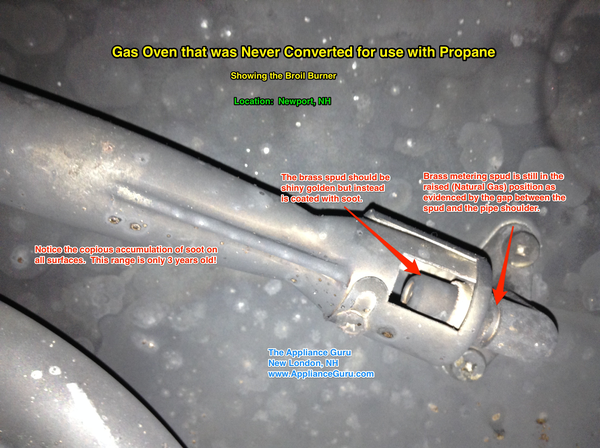
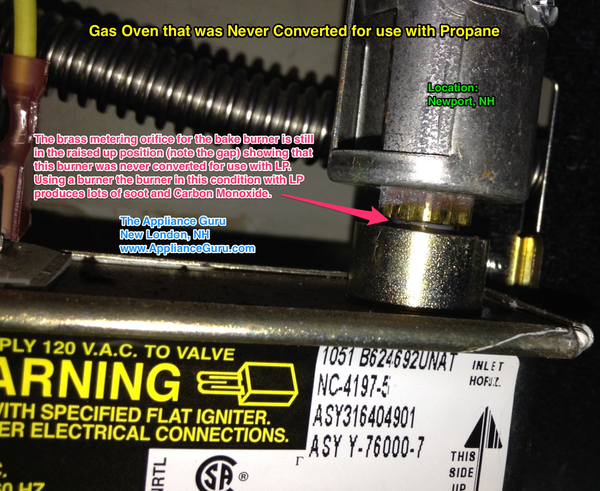
To make matters even worse, when the customer called the retailer’s customer service department to complain about the soot in the oven, they advised her to run the self clean feature which successfully produced copious amounts of soot and, at the 900F temperatures reached in the oven cell during self clean, baked the soot onto the oven walls. The soot will never come out. This range is only three years old and the oven is effectively ruined.
So how is the strange and mysterious conversion process done in gas ranges? It’s really not a mystical experience at all. It’s as simple as following the instructions and installing a few pieces that all manufacturers provide for this very purpose. For example, here is an official conversion instruction sheet that Frigidaire includes with the conversion kits for its ranges.
